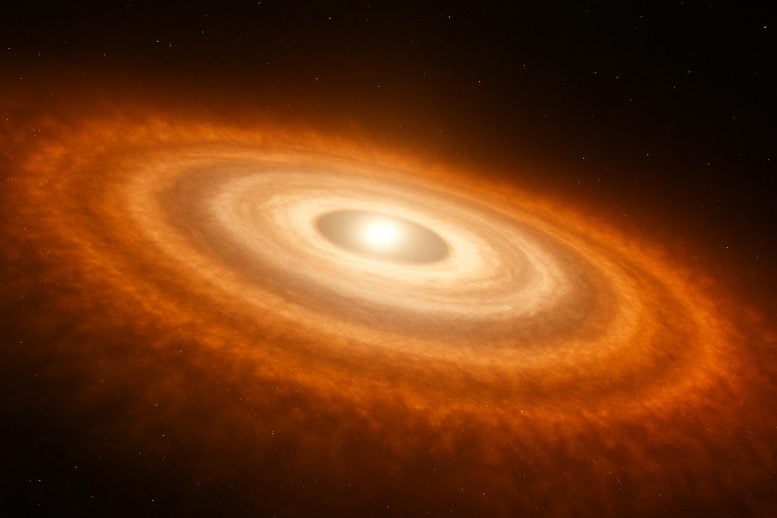
A young star’s disk shows unexpectedly high CO₂ and little water. The result questions standard theories of planet formation.
A research team led by Jenny Frediani at Stockholm University has identified a planet-forming disk with an unexpectedly unusual chemistry: it contains far more carbon dioxide (CO₂) than anticipated in areas where Earth-like planets may eventually emerge. This observation, made with the James Webb Space Telescope (JWST), calls into question long-held views about the chemical environment of planetary nurseries. The results have been published in Astronomy & Astrophysics.
“Unlike most nearby planet-forming disks, where water vapor dominates the inner regions, this disk is surprisingly rich in carbon dioxide,” says Jenny Frediani, PhD student at the Department of Astronomy, Stockholm University.
“In fact, water is so scarce in this system that it’s barely detectable — a dramatic contrast to what we typically observe.”
Challenging models of planet formation
When a star first forms, it remains buried within the dense gas cloud that gave rise to it and generates a surrounding disk where planets may later develop.
Standard models of planet formation suggest that icy pebbles from the cold outer regions drift inward, releasing water vapor as the ice sublimates in the warmer inner zones. This process normally produces strong water vapor signals in the disk’s interior. In this instance, however, the JWST/MIRI spectrum revealed an unexpectedly dominant carbon dioxide signature instead.

“This challenges current models of disk chemistry and evolution since the high carbon dioxide levels relative to water cannot be easily explained by standard disk evolution processes,” Jenny Frediani explains.

Arjan Bik, researcher at the Department of Astronomy, Stockholm University, adds, “Such a high abundance of carbon dioxide in the planet-forming zone is unexpected. It points to the possibility that intense ultraviolet radiation — either from the host star or neighboring massive stars — is reshaping the chemistry of the disk.”
Isotopic fingerprints in carbon dioxide
The team also identified uncommon isotopic forms of carbon dioxide, enriched with either carbon-13 or the oxygen isotopes ¹⁷O and ¹⁸O, which appeared distinctly in the JWST data. These isotopologues may provide important insights into long-standing questions about the unusual isotopic patterns observed in meteorites and comets, which are remnants from the early formation of our Solar System.
This CO₂-rich disk was found in the massive star-forming region NGC 6357, located approximately 1.7 kiloparsecs (about 53 quadrillion kilometers) away. The discovery was made by the eXtreme Ultraviolet Environments (XUE) collaboration, which focuses on how intense radiation fields impact disk chemistry.
Implications for planetary systems and atmospheres
Maria-Claudia Ramirez-Tannus from the Max Planck Institute for Astronomy in Heidelberg and lead of the XUE collaboration says that it is an exciting discovery: “It reveals how extreme radiation environments — common in massive star-forming regions — can alter the building blocks of planets. Since most stars and likely most planets form in such regions, understanding these effects is essential for grasping the diversity of planetary atmospheres and their habitability potential.”
Thanks to JWST’s MIRI instrument, astronomers can now observe distant, dust-enshrouded disks with unprecedented detail at infrared wavelengths — providing critical insights into the physical and chemical conditions that govern planet formation. By comparing these intense environments with quieter, more isolated regions, researchers are uncovering the environmental diversity that shapes emerging planetary systems. Astronomers at Stockholm University and Chalmers have helped develop the MIRI instrument, which is a camera and a spectrograph that observes mid- to long-wavelength infrared radiation from 5 microns to 28 microns. It also has coronagraphs, specifically designed to observe exoplanets.
Reference: “XUE: The CO2-rich terrestrial planet-forming region of an externally irradiated Herbig disk” by Jenny Frediani, Arjan Bik, María Claudia Ramírez-Tannus, Rens Waters, Konstantin V. Getman, Eric D. Feigelson, Bayron Portilla-Revelo, Benoît Tabone, Thomas J. Haworth, Andrew Winter, Thomas Henning, Giulia Perotti, Alexis Brandeker, Germán Chaparro, Pablo Cuartas-Restrepo, Sebastian Hernández A., Michael A. Kuhn, Thomas Preibisch, Veronica Roccatagliata, Sierk E. van Terwisga and Peter Zeidler, 29 August 2025, Astronomy & Astrophysics.
DOI: 10.1051/0004-6361/202555718
Funding: Swedish National Space Agency, Deutsches Zentrum für Luft- und Raumfahrt, HORIZON EUROPE European Research Council, Royal Society Dorothy Hodgkin Fellowship, Deutsche Forschungsgemeinschaft, H2020 European Research Council
Never miss a breakthrough: Join the SciTechDaily newsletter.
2 Comments
Bahaha,, thats ah good one Lord. The Great I Am is beyond fathoming but is the very definition of Love,, and humbling even brilliant human minds. There’s no such thing as evolution,, only Creation n Adaptation.
Star needs to drink more water…